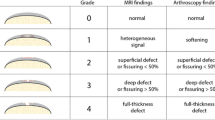Abstract
Purpose
This study assesses the accuracy of 3-Tesla (3-T) conventional MR imaging, 3-T MR arthrography, and the combined use of conventional MR and MR arthrography in the diagnosis of meniscal retears as compared with arthroscopy. The study also assess whether there are false-negative cases in which injected contrast does not extend into the meniscus despite a meniscal retear being seen on arthroscopy.
Materials and methods
One hundred consecutive knee MR arthrograms performed on patients with previous knee surgery were reviewed retrospectively. 3-T conventional MR imaging, 3-T MR arthrography, and the combined use of conventional MR and MR arthrography were assessed for meniscal retears as compared with arthroscopy. The criterion used to diagnose a meniscal retear on MR arthrogram was injected contrast tracking into the meniscus. All patients underwent second-look arthroscopy.
Results
Seventy-four patients had conventional MR findings consistent with a meniscal retear. In 83 of the 100 patients, intraarticular contrast helped in demonstrating a retear. In ten patients, there were MR findings consistent with a meniscal retear despite intra-articular contrast not tracking into the meniscus. Ninety-four of the 100 patients had meniscal retears on second-look arthroscopy. Three-Tesla conventional MR examination was 78 % sensitive and 75 % specific, MR arthrogram examination was 88 % sensitive and 100 % specific, and the combined use of MR and MR arthrogram imaging was 98 % sensitive and 75 % specific in the diagnosis of a meniscal retear.
Conclusions
The combined use of 3-T MR and MR arthrography allows for high sensitivity and specificity in meniscal retear detection. In some patients, intraarticular contrast will not track into a meniscal retear. When MR findings are consistent with a meniscal retear but contrast does not extend into the meniscus, a meniscal retear is likely.






Similar content being viewed by others
References
McCauley TR. MR imaging evaluation of the postoperative knee. Radiology. 2005;234(1):53–61.
Totty WG, Matava MJ. Imaging the postoperative meniscus. Magn Reson Imaging Clin N Am. 2000;8:271–84.
Haims AH, Katz LD, Ruwe PA. MR arthrography of the knee. Semin Musculoskelet Radiol. 1998;2:385–95.
Trattnig S, Rand T, Czerny C, et al. Magnetic resonance imaging of the postoperative knee. Top Magn Reson Imaging. 1999;10:221–36.
Applegate GR, Flannigan BD, Tolin BS, et al. MR diagnosis of recurrent tears in the knee: value of intraarticular contrast material. AJR Am J Roentgenol. 1993;161:821–5.
Sciulli RL, Boutin RD, Brown RR, et al. Evaluation of the postoperative meniscus of the knee: a study comparing conventional arthrography, conventional MR imaging, MR arthrography with iodinated contrast material, and MR arthrography with gadolinium-based contrast material. Skeletal Radiol. 1999;28:508–14.
Magee TH, Shapiro MD, Rodriguez JR, et al. MR arthrography of postoperative knee: for which patients is it useful? Radiology. 2003;229(1):159–63.
Robbins MI, Anzilotti KF, Katz LD, et al. Patient perception of magnetic resonance arthrography. Skeletal Radiol. 2000;29:265–9.
White LM, Schweitzer ME, Weishaupt D, et al. Diagnosis of recurrent meniscal tears: prospective evaluation of conventional MR imaging, indirect MR arthrography, and direct MR arthrography. Radiology. 2002;222:421–9.
De Smet AA, Horak DM, Davis KW, et al. MR diagnosis of recurrent tears in the knee: value of intraarticular contrast material. AJR Am J Roentgenol. 2006;187:W565–8.
Conflict of interest
There are no conflicts of interest to disclose.
Author information
Authors and Affiliations
Corresponding author
Rights and permissions
About this article
Cite this article
Magee, T. Accuracy of 3-Tesla MR and MR arthrography in diagnosis of meniscal retear in the post-operative knee. Skeletal Radiol 43, 1057–1064 (2014). https://doi.org/10.1007/s00256-014-1895-5
Received:
Revised:
Accepted:
Published:
Issue Date:
DOI: https://doi.org/10.1007/s00256-014-1895-5




